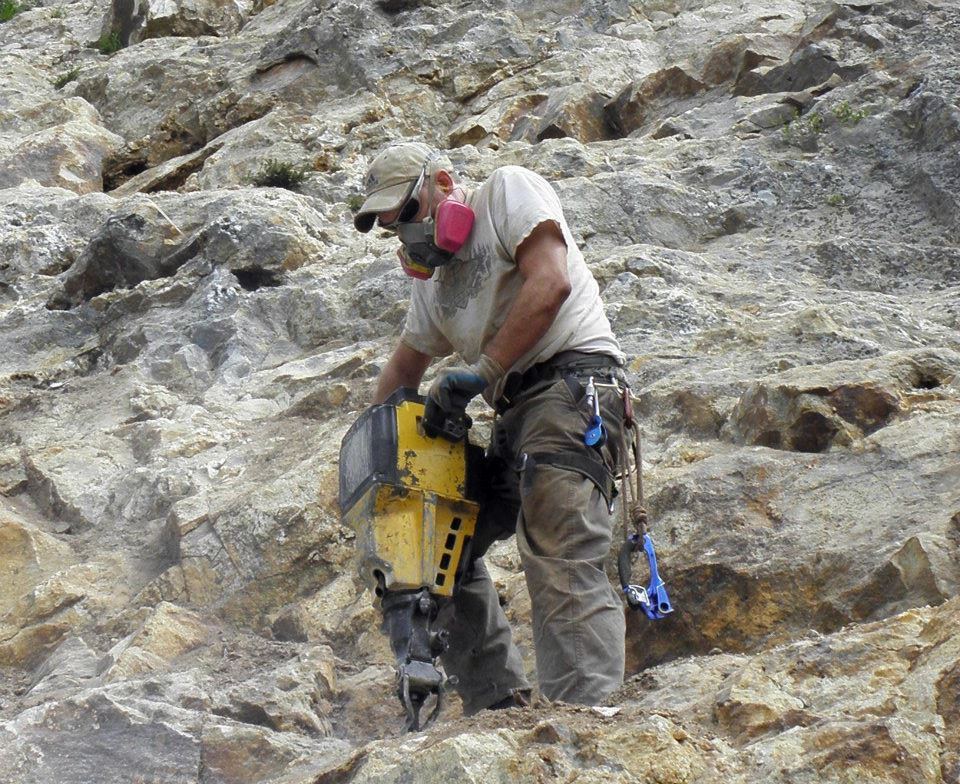Hand-arm vibration syndrome (HAVS)
Contents |
[edit] Introduction
Hand-arm vibration syndrome (HAVS) is a disorder that workers in construction can be at risk of if they use vibrating tools for long periods of time. Hand-held and hand-guided power tools can cause symptoms in fingers, hands and arms, and although preventable, the damage caused is permanent.
It is unclear exactly how vibration leads to HAVS, but it is generally thought to be small, repeated injuries that are sustained by nerves and blood vessels in the fingers, as well as the joints of hand, wrist and arm, which gradually lose function.
Equipment that can pose a risk of HAVS include:
- Chainsaws.
- Chipping hammers.
- Concrete breakers.
- Disc cutters.
- Grinders.
- Hammer drills
- Pneumatic drills.
- Sanders.
- Scabblers.
- Pedestal grinders.
It is unusual for an operative to develop HAVS unless they use equipment for at least 10 years, but there is a risk if hammer tools are used for more than around 15 minutes per day, or if rotary, or other action tools are used for more than around 1 hour per day.
[edit] Control of Vibration at Work Regulations 2005
The Control of Vibration at Work Regulations were introduced under the Health and Safety at Work etc. Act 1974, to improve protections for workers from the risks of vibration. They place a duty of care on employers to reduce employees’ risk from vibration.
Employers must make an assessment the ‘exposure limit value’ and ‘exposure action value’. The ‘exposure limit value’ is the maximum exposure in one day by an employee; while the ‘exposure action value’ is the daily level at which employers must take controlling measures.
A formula calculates the average (A) exposure over an 8-hour day. These values are referred to as A(8). A machine or tool’s vibration rate is measured in metres per second, and referred to as m/s2.
| Daily Exposure Action Value | Daily Exposure Limit Value | |
| Hand-arm vibration | 2.5 m/s² A(8) | 5 m/s² A(8) |
[edit] Symptoms
Some of the early symptoms that can be experienced by operatives include:
- Numbness and loss of feeling in fingers.
- Pins-and-needles and tingling sensations in fingers.
- Loss of dexterity (i.e. difficulty trying to fasten buttons, handle small items, etc.).
- Loss of strength in the hands.
- Vibration white finger (the tips of fingers go white in cold and damp weather).
Later symptoms can include:
- Permanent numbness in the hands.
- A permanent lack of, or reduced, dexterity.
- More frequent and more painful vibration white finger.
[edit] Safety and prevention measures
It is the responsibility of the employer to take safety and preventative measures, although operatives can also take steps themselves:
- Using suitable low-vibration tools.
- Using the right tool for the right job.
- Checking tools are properly maintained and repaired.
- Spreading work activities, or taking regular breaks.
- Holding tools with a loose grip and in varying positions.
- Preventing tools from getting cold.
- Keeping hands warm while working.
- Encouraging good blood circulation in the hands and fingers, by keeping them warm, exercising fingers and so on.
Operatives that are exposed to vibration should be able to recognise the early signs and symptoms of HAVS and have a health and safety officer who they can report to. They should also be aware of the control measures that the employer should have in place.
NB: In October 2018, concrete contractor Castle & Pryor announced it had developed the 'Sindrilla' frame-mounted drilling system as a direct replacement for traditional hand-held rotary percussion drilling, intended to prevent HAVS.
[edit] Prosecution
In 2018, following an investigation by HSE, Balfour Beatty Utility Solutions was prosecuted for exposing its workers to hand-arm vibration between 2002 and 2011. They pleaded guilty to breaching the requirements of the Health and Safety at Work etc. Act 1974 and the Reporting of Injuries, Diseases and Dangerous Occurrences Regulations 1995, and were fined £500,000 and ordered to pay costs of £195,000.
HSE inspector Christine Mellor said; “Exposure to hand-arm vibration is a well-known risk which Balfour Beatty Utility Solutions Ltd failed to adequately control. The company failed to heed warnings. Early health surveillance detected ill health but still this was not acted upon to prevent on-going exposure... This is a particularly serious case because of the extent and duration of failures. The breaches were repeated over several years and this resulted in persistent poor compliance.”
(Ref. HSE 2018)
[edit] Technology
In March 2019, it was announced that Reactec and CoreRFID had developed HAVwear, a device worn like a watch to monitor vibration exposure when using power tools.
[edit] Related articles on Designing Buildings
Featured articles and news
Homes England creates largest housing-led site in the North
Successful, 34 hectare land acquisition with the residential allocation now completed.
Scottish apprenticeship training proposals
General support although better accountability and transparency is sought.
The history of building regulations
A story of belated action in response to crisis.
Moisture, fire safety and emerging trends in living walls
How wet is your wall?
Current policy explained and newly published consultation by the UK and Welsh Governments.
British architecture 1919–39. Book review.
Conservation of listed prefabs in Moseley.
Energy industry calls for urgent reform.
Heritage staff wellbeing at work survey.
A five minute introduction.
50th Golden anniversary ECA Edmundson apprentice award
Showcasing the very best electrotechnical and engineering services for half a century.
Welsh government consults on HRBs and reg changes
Seeking feedback on a new regulatory regime and a broad range of issues.
CIOB Client Guide (2nd edition) March 2025
Free download covering statutory dutyholder roles under the Building Safety Act and much more.
Minister quizzed, as responsibility transfers to MHCLG and BSR publishes new building control guidance.
UK environmental regulations reform 2025
Amid wider new approaches to ensure regulators and regulation support growth.
BSRIA Statutory Compliance Inspection Checklist
BG80/2025 now significantly updated to include requirements related to important changes in legislation.























